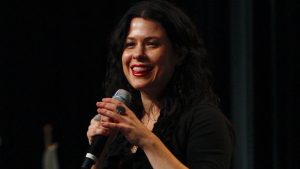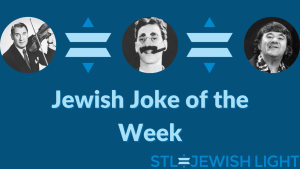UH welcomes new Torah
Published October 3, 2007
United Hebrew Congregation made a bit of history this week when it welcomed its new Torah, completing its yearlong “Torah Alive!” celebration. The Torah is thought to be the first ever completely written by a woman.
On Monday, leaders of the congregation greeted Torah scribes Jen Taylor Friedman and Neil Yerman and the new Torah scroll at Lambert-St. Louis International Airport. The joy and excitement continued into the evening as the congregation officially received the new Torah from Friedman in a special ceremony. The Torah was passed around to religious and lay leaders and ended in the arms of Yerman, who represented the congregation and everyone who wrote in the Torah.
The project actually was a two-year journey from planning to completion. The level of involvement of the congregation in terms of volunteers and program participation delighted and exceeded the expectations of everyone involved in the project.
“When we decided to commission a new Torah, we hoped it would encourage extensive, active involvement on the part of the congregation,” said Rabbi Howard Kaplansky. “It was very exciting and very satisfying.”
Program co-chairs Sue Koblin and Karen Wasserman said they were not sure how the project would be received when they started it a year ago. However they were overwhelmed by the level of participation. People came from everywhere to donate hundreds of volunteer hours and lend their special skills to be part of the project. There were so many opportunities to get involved that there was something for everyone to do, said congregational president Ron Gieseke.
“To say the Temple completely embraced the project is truly an understatement,” Koblin said.
Many people reflecting on the project agreed that the educational programs and the opportunity to write in the Torah were highlights of the yearlong celebration.
Participants had the opportunity to write the first few columns of Genesis with Yerman. It was an incredibly moving experience for everyone involved. The oldest person participating was 101 years old, and the youngest was an infant, only a few months old. Kaplansky said watching families gathering and waiting to write in the Torah was unlike any other experience.
Rabbi Brigitte Rosenberg also enjoyed watching the multiple generations of families come together at the different writing sessions. She observed people connecting with other congregants as they awaited their turn to write. Then she would see them after the writing — some crying, needing to sit and sift through the mix of emotions of the powerful shared experience.
Rosenberg had the opportunity to write in the Torah on her own at the project kick-off a year ago and then recently with her young family. She recalled her children had been sitting for a while before it became their turn to write. A photograph was taken before everyone wrote in the Torah.
“When the pictures came back I could see our kids intently concentrating on the Torah, on the writing, involved in the moment,” Rosenberg said. “Every generation of our congregation has been touched by the whole project and having it scribed by Jen is the icing on the cake.”
Friedman didn’t plan on making history when she took on the project of writing the new Torah. Nor was it the intent of the congregation, which just needed a new Torah. However, it did present an opportunity to make a wonderful statement.
“I am very proud of our congregation and the statement it made about ourselves and to ourselves,” Kaplansky said. “It celebrates a rebirth for the congregation and for Judaism to have a Torah scribed entirely by a female scribe and taking the steps to make that possible.”
On Sept. 5 Friedman wrote in her online blog that she had completed 100 percent of the Torah, except for the last 12 words she would write in St. Louis. A few days later the completed Torah was presented at the Drisha Institute for Jewish Education in New York as the first Torah to be scribed by a woman. The event is considered to be a historic milestone for Jewish women.
Friedman has given some thought to the significance and historic implications of completing the first Torah scribed entirely by one woman. She reflected on the real meaning of egalitarianism in Judaism which she said still requires boys to wear kippot, tallit and tefillin but doesn’t require it of girls. She also is concerned with women receiving equal pay for equal work and gender discrimination.
“I think that until this kind of invisible, all-pervading gender discrimination is gone from the egalitarian movements, my having written a Torah will be essentially irrelevant,” Friedman said in an e-mail interview. “If I can inspire women or girls to value themselves as much as they are taught to value their male peers, I will have achieved something worthwhile. I fear, though, that that is a great deal harder than writing a Torah.”
Making the Torah writing process truly egalitarian was an important component for the congregation. The first section of the Torah written by Friedman was removed and replaced with the portion written by the congregants with Yerman. The section written by Friedman will remain preserved at the synagogue.
This past Shabbat, bat mitzvah Rachel Kazen, daughter of Leslie and Andy Kazen, was the last person to read from the retiring Torah. She said she felt the need to do a “good job” to honor all the generations before her.
“Looking out at the congregation I was reminded of all the people who read from this same Torah before me,” Kazen said.
Carli Rabon, daughter of Barb Whalen and David Rabon, will be the first bat mitzvah to read from the new Torah. She feels the significance of the day beyond just her bat mitzvah. She enjoys the connection of a bat mitzvah being the first person to read from the first Torah scribed entirely by a woman.
“It’s kind of overwhelming,” Rabon said. “It is a new start for many, many generations to come.”
The entire experience has been a reaching back and a look to the future for the entire congregation. It has been more than just another project: it has been a historic event for the congregation. Over 40 percent of the membership wrote in the Torah, said Gieseke.
Four generations of Wasserman’s family participated in writing in the Torah: her grandmother, who was the oldest person to write in the Torah, her parents, she and her husband and their children.
“It is hard to express the emotions knowing this Torah will be used by my great-grandchildren,” Wasserman said. “This project has provided all of us with a connection to Torah, with religion and to our community. It has even touched beyond the walls of the congregation.”














